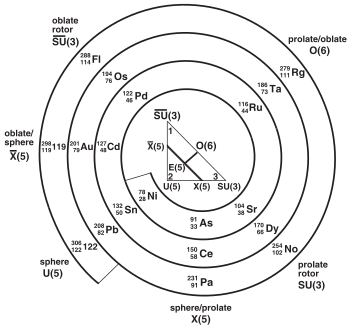| Nuclear physics |
|---|
 |
The interacting boson model (IBM) is a model in nuclear physics in which nucleons (protons or neutrons) pair up, essentially acting as a single particle with boson properties, with integral spin of either 2 (d-boson) or 0 (s-boson). They correspond to a quintuplet and singlet, i.e. 6 states.
It is sometimes known as the Interacting boson approximation (IBA).[1]: 7
The IBM1/IBM-I model treats both types of nucleons the same and considers only pairs of nucleons coupled to total angular momentum 0 and 2, called respectively, s and d bosons.
The IBM2/IBM-II model treats protons and neutrons separately.
Both models are restricted to nuclei with even numbers of protons and neutrons.[1]: 9

The model can be used to predict vibrational and rotational modes of non-spherical nuclei.[2]
History[edit]
This model was invented by Akito Arima and Francesco Iachello in 1974.[1]: 6 while working at the Kernfysisch Versneller Instituut(KVI) in Groningen, Netherlands. KVI is now property of Universitair Medisch Centrum Groningen (https://umcgresearch.org/).
See also[edit]
References[edit]
- Arima, A.; Iachello, F. (1975-10-20). "Collective Nuclear States as Representations of a SU(6) Group". Physical Review Letters. 35 (16). American Physical Society (APS): 1069–1072. Bibcode:1975PhRvL..35.1069A. doi:10.1103/physrevlett.35.1069. ISSN 0031-9007.
- Iachello, F; Arima, A. (1987). The Interacting Boson Model. Cambridge: Cambridge University Press. ISBN 978-0-511-89551-7. OCLC 776970502.
- Arima, A; Iachello, F (1976). "Interacting boson model of collective states I. The vibrational limit". Annals of Physics. 99 (2). Elsevier BV: 253–317. Bibcode:1976AnPhy..99..253A. doi:10.1016/0003-4916(76)90097-x. ISSN 0003-4916.
- Arima, A; Iachello, F (1978). "Interacting boson model of collective nuclear states II. The rotational limit". Annals of Physics. 111 (1). Elsevier BV: 201–238. Bibcode:1978AnPhy.111..201A. doi:10.1016/0003-4916(78)90228-2. ISSN 0003-4916.
- Scholten, O; Iachello, F; Arima, A (1978). "Interacting boson model of collective nuclear states III. The transition from SU(5) to SU(3)". Annals of Physics. 115 (2). Elsevier BV: 325–366. Bibcode:1978AnPhy.115..325S. doi:10.1016/0003-4916(78)90159-8. ISSN 0003-4916.
- Arima, A; Iachello, F (1979). "Interacting boson model of collective nuclear states IV. The O(6) limit". Annals of Physics. 123 (2). Elsevier BV: 468–492. Bibcode:1979AnPhy.123..468A. doi:10.1016/0003-4916(79)90347-6. ISSN 0003-4916.
- Arima, A; Iachello, F (1981). "The Interacting Boson Model". Annual Review of Nuclear and Particle Science. 31 (1). Annual Reviews: 75–105. Bibcode:1981ARNPS..31...75A. doi:10.1146/annurev.ns.31.120181.000451. ISSN 0163-8998.
- Talmi, Igal (1993). Simple models of complex nuclei : the shell model and interacting boson model. Chur, Switzerland Langhorne, Pa., U.S.A: Harwood Academic Publishers. ISBN 978-3-7186-0550-7. OCLC 25706648.
- ^ a b c Walter Pfeifer (1998). An Introduction to the Interacting Boson Model of the Atomic Nucleus (PDF). ISBN 978-3-7281-2520-0.
- ^ a b Kratz, J. V. (5 September 2011). The Impact of Superheavy Elements on the Chemical and Physical Sciences (PDF). 4th International Conference on the Chemistry and Physics of the Transactinide Elements. Retrieved 27 August 2013.
Further reading[edit]